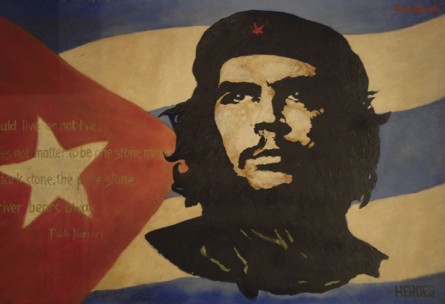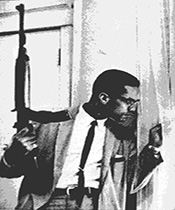The Havana Sights
Like I said in Part One, I don’t want to give the impression that the only thing to see or do in Cuba is some sort of political science exercise. In fact, Cuba is a wonderfully beautiful city both in terms of landscape and its people. Here are a few attractions I took in during my stay in Havana – every single one of them worthwhile. Remember 1 CUC = 1.20 USD (so 100 CUC is $120 USD) and as an American you won’t be able to reserve/purchase online nor use your credit/debit cards.
.jpg) Tropicana
Tropicana
The original Tropicana opened in Havana in 1939 and copied in Las Vegas in the 1950s. The Tropicana is both an indoor restaurant and a large outdoor open-air theater. Gone are the days of the extremely risqué burlesque shows, there’s no nudity or even sexually suggestive routines in the show. In addition, it’s no longer a casino as gambling is illegal in Cuba. What the cabaret show does offer are excellently choreographed song and dance routines over about a 2 hour period. Shows run every day except Monday at about 9pm – weather permitting. The show is excellent – rivals anything you’d see on Broadway or Las Vegas. As part of the entry fee, the servers bring over a plate of appetizers, a can of cola, a pint of rum and a decent quality Cuban cigar – try that on Broadway! I won’t lie though – the show is unnecessarily expensive (likely because the audience is 99% tourists). The show plus dinner is $111 CUC; show only is 70 CUC and the fee to take Video is an additional $10 CUC.
.jpg) La Cabaña Fortress
La Cabaña Fortress
Originally built in the 18th century to protect Havana against invading forces, it now serves as a giant museum containing artifacts from the period. The fort is allegedly the largest in North America and contains all of the things you’d expect in such a structure including a drawbridge, moat, cannons and watch towers but also includes a few museums. I’d suggest visiting the fort at night for two reasons: first you can take pretty nice night landscape pictures of the Havana skyline from across the bay. Granted, Havana’s skyline isn’t as lit up as most other cities – but it’s still a worthwhile picture. Secondly, a cannon blast ceremony is performed every evening at 9pm sharp. Characters in 1800s military garb get into formation and fire off a blank shell in which the blast can be heard miles across town (locals say they set their watch to the blast). Admission is 5 CUC (I think).
.jpg) El Malecón
El Malecón
The Malecón is simply a roadway on the seawall against the Havana Bay that stretches from the Havana Harbor to the neighborhood of Vedado. While the 5 mile stretch of road isn’t so much of a an attraction itself – it is where a number of attractions are located including the Hotel National and US Special Interest section. More interesting is the number of sections where waves of water blast over the seawall onto passersby and cars, the teenagers jumping off of the rocks into the water for a swim, excellent panoramic pictures of the Havana skyline and the wonderful Cuban people simply enjoying themselves walking along the shoreline. As I walked along the Malecón looking at the beautiful ocean on one side and miles of vacant and/or dilapidated buildings on the other, I couldn’t help think how bad the Hiltons, Marriotts, etc. of the world are just dying to get a piece of the action. With literally miles of oceanfront property – it’s not hard to imagine Havana turning into Cancun II once the embargo is lifted.
.jpg) Havana Club Rum Factory
Havana Club Rum Factory
Agriculturally speaking, Cuba has an abundance of sugar cane and tobacco. As sugar is the basis of Molasses – which in turn is the basis of Rum – there is also no shortage of this alcoholic beverage. Havana Club is the most popular brand of Rum in Cuba and they offer a tour of one of their facilities. Though more of a museum than a production facility, there were barrels and vats of rum in various stages of the fermentation process, as well as a history of the Rum producing process starting from the 1700s (detailing slavery’s impact) to current day operations. Tours are conducted by Havana Club employees and are given in Spanish, English, German and I think French. Tours lasts about an hour, costs 14 CUC and you can sample either their light or dark rums at the end of the tour.
.JPG)
Sometimes referred to as Revolution Plaza/Square; it is where a number of political rallies take place – some put on by the government others as political protests. In terms of things to see, the most grandiose is the Jose Marti Memorial – which includes a statue of the national hero and an over 350ft tall tower. You can take an elevator to the top of the tower for excellent city views but I can’t remember why I didn’t. Perhaps the most photographed monument in the square is the image of Che Guevara on the outside of the Ministry of the Interior. Just as large of an image is of Fidel Castro Camilo Cienfuegos on the adjacent building but I don’t know what that building is though which is the Ministry of Informatics and Communication. If you are dying to see and/or ride in a Coco taxi – there are at least 20 of them at any given time in and around the square.
.jpg) US Special Interest Section
US Special Interest Section
Not much of an attraction (if you can call it that) now that the US has stopped antagonizing the Cuban government – but it is interesting enough to walk/drive by to get a sense of the atmosphere. The Special Interest section is the closest thing the US has to an embassy in Cuba. This was the only time I witnessed police officers numbering more than 1 during the entire time I was in Havana. It’s hard to tell whether their primary goal is to protect the Americans inside from the Cuban population or the Cubans from the American propaganda; perhaps a little of both. Check out the electronic billboard (now turned off) that frequently spewed the US’s political agenda to the Cuban people and the 100 or so flag-poles erected by the Cuban government to obscure said billboard from being seen.
.jpg) Hotel Nacional de Cuba
Hotel Nacional de Cuba
Originally opened in 1930s, the Hotel National is probably the most famous hotel in Cuba – though no longer the most luxurious. If you are looking to stay within the city limits in luxury accommodations with stunning views of the water, this is one of the best places to stay. In addition, there’s a good deal of history within the hotel, including sections built by US mobster Meyer Lansky during the casino years and rooms where Frank Sinatra & Ernest Hemmingway stayed. Believe it or not, fake high-end cigars are a rampant problem in Cuba. Now, even the fake cigars are made from Cuban tobacco (unlike those found in Miami) – they just may not be the Montecristo, Habanos, etc. the seller claims they are. One place you can ensure you are getting the real thing is the Cigar shop in the Hotel National.
.jpg) Habana Libre (Havana Hilton)
Habana Libre (Havana Hilton)
Originally the Hilton Hotel until Castro nationalized the property and made it his headquarters shortly after the Revolution. The property itself is showing its age so the more interesting aspect is the El Turquino club on the top floor of the hotel. Around midnight, the entire the roof opens exposing the moon & stars as partygoers dance into the wee hours of the morning to salsa, reggae and yes – Spanish & American Hip-Hop. (Didn’t get to do).
.jpg) Coppelia Ice Cream Parlor
Coppelia Ice Cream Parlor
Another institution in Havana; Coppelia is a perfect way to get away from the sun and cool off. The complex, which spans nearly an entire city block – has two floors, ice cream serving bar and waiters. You should note that there are two economies for purchasing ice cream from this establishment – the first is intended for locals and the other is intended for tourists. If you are a local, a cup of ice cream is 20 CUD (about 70 cents). If you are a tourist and paying with CUC, you need to walk around the building to a special section and pay 3 CUC ($3.60 US). I asked the guy who raped me took my money whether there’s any difference between the ‘tourist’ and the ‘local’ versions of ice cream. He said the tourist version used real cream instead of powdered milk; a claim I certainly find plausible – but not worth over $3 a scoop! The lesson here is always carry a few CUP for personal items such as street food and unmetered cabs.
.jpg) National Capital Building
National Capital Building
“El Capitolio” was originally the seat of government for the entire country until Fidel’s Revolution. Built in 1930, the capital building’s exterior is almost an exact replica of the US Congress building in Washington, DC – the Cuban version’s dome is exactly 4ft taller than its US counterpart. The irony of this little nugget of information is unbelievable. The building is now home to the Cuban Academy of Sciences.
.jpg) Havana Cathedral
Havana Cathedral
Officially known as the Cathedral de San Cristóbal de La Havana; is a Roman Catholic church in the Old Havana district. According to Wikipedia: “the Cathedral is said to be the only example of a baroque facade that was designed with asymmetrical features” as the left tower is taller and narrower than the right. Even though it’s a popular tourist site, it is also an in service church so be respectful when visiting.
.jpg) Circa 1950s Auto Tour
Circa 1950s Auto Tour
Right outside of the Hotel National usually sits 5-10 1950s era American automobiles waiting to take tourists around the city of Havana. Oldsmobiles, Cadillacs and Buicks in several different colors and configurations (several were convertibles) were available for guided tours from 1 to 3 hours. I choose a 1-hour tour in a pink convertible 1952 Buick (I’m not sure what model) – which took me all over the Havana city limits, including the Plaza of the Revolution, up the Malecón, Old Havana and Vedado neighborhoods and Hemingway Marina amongst others. Even stopped at a street food vendor in the middle of the city in what seemed like a swamp/jungle where I was also offered very cheap Montecristos and a pork kebab. Rides start at 20 CUC per hour from Gran Tour Company.
.jpg) Cementerio de Colón (Cemetery)
Cementerio de Colón (Cemetery)
If you’ve ever been to the cemeteries in New Orleans, then Havana’s version looks fairly similar. If you haven’t been to an above ground cemetery, Havana’s version compares favorably with just about every one I’ve seen. Around since the 1870s, Colon sits in the middle of the Vedado neighborhood and contains over 800,000 graves and over 500 major mausoleums/family structures – some spanning 30ft into the air. Along with the tombs, vaults and family structures themselves, the front entrance (which was under construction when I visited) and the main chapel are excellent options for taking photos. The HavanaBusTour bus stops right in front of the cemetery entrance if you don’t want to take a cab. Admission is free.
I accomplished a good deal in my 4 days in Havana, but I still missed the opportunity to take the Partagas Cigar Factory Tour due to a little housing snafu. In addition, my early flight out of Havana on Sunday caused me to miss the Sábado de la Rumba – an Afro-Cuban street festival in the Callejón de Hamel district (street art).
Next Page: Things That Stuck With Me















Pingback: havana | m y s e a s t o r y